Abstract
Sera from 100 children (ages, 6 to 16 years) presenting with upper gastrointestinal symptoms were examined for antibodies to Helicobacter pylori by enzyme-linked immunosorbent assay (ELISA) based on crude, loosely cell-associated antigens and a partially purified urease antigen preparation. All children underwent endoscopy, and 20 children were shown to have H. pylori infection by histology or direct culture. Serum anti-H. pylori immunoglobulin G (IgG) levels (crude antigen) were clearly raised in the infected group, particularly after preabsorption of sera against a Campylobacter jejuni antigen preparation, while IgM and IgA ELISA determinations did not discriminate between infected and H. pylori-negative patients. Only 14 children in the infected group had raised anti-urease IgG levels. Two patients in whom the organism was not demonstrated or cultured had raised specific IgG levels against both crude and urease antigens and pathological features consistent with H. pylori disease. Immunoblotting studies did not reveal any single protein antigen or simple combination of antigens that could be considered as a candidate for a more defined serodiagnostic reagent. Anti-H. pylori antibody determinations (crude antigen) performed on posttreatment samples from children in whom the organism could no longer be demonstrated suggested that sustained IgG levels may not be a reliable index of treatment failure. An IgG ELISA based on crude, loosely cell-associated antigens of H. pylori can be used for the serodiagnosis of H. pylori infection in childhood.
Full text
PDF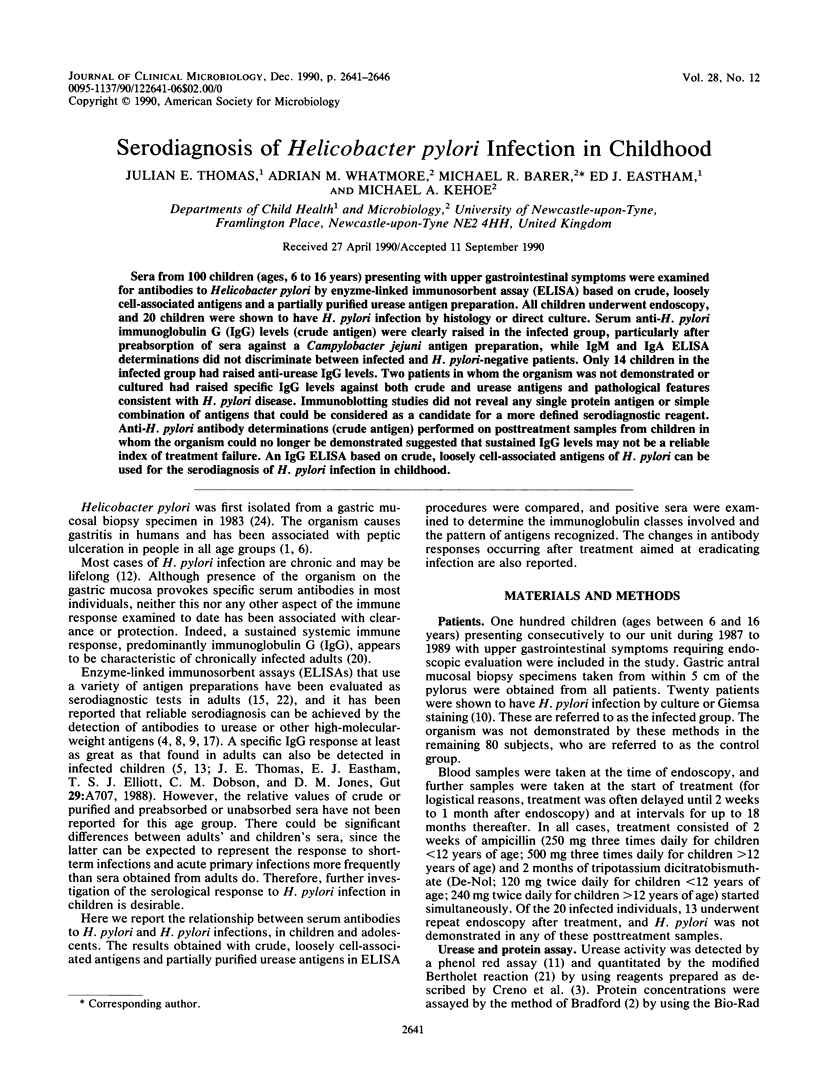
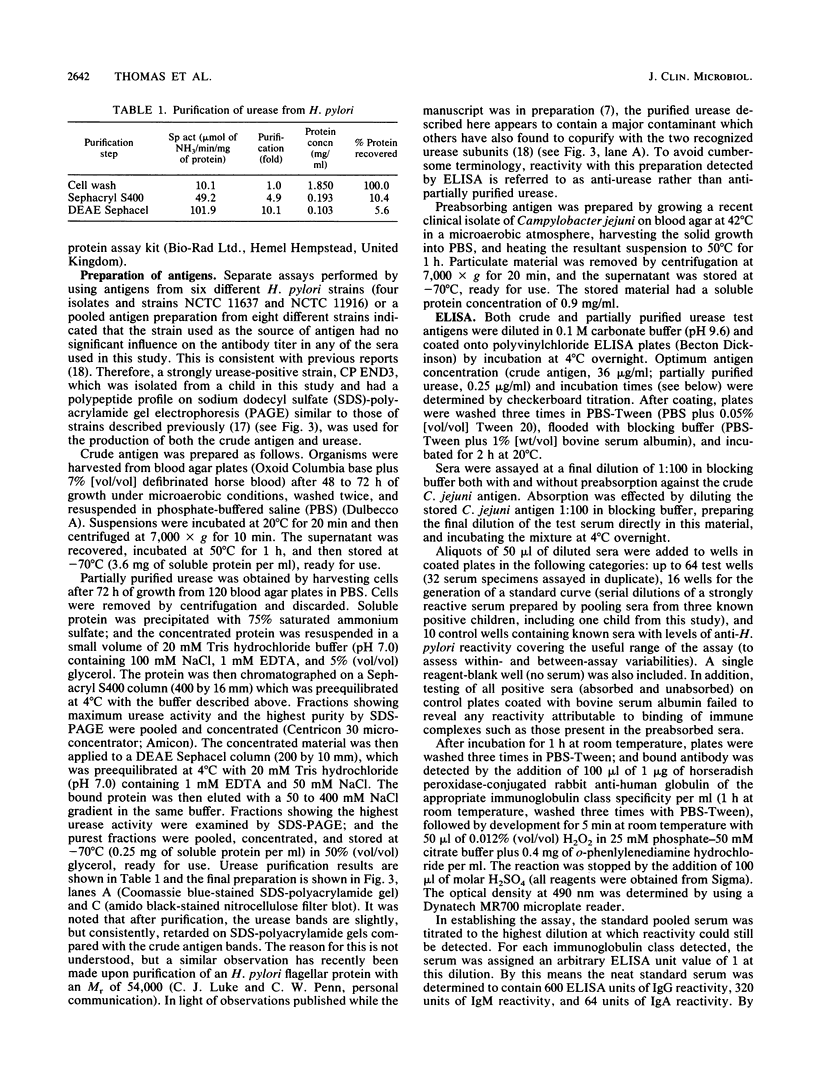
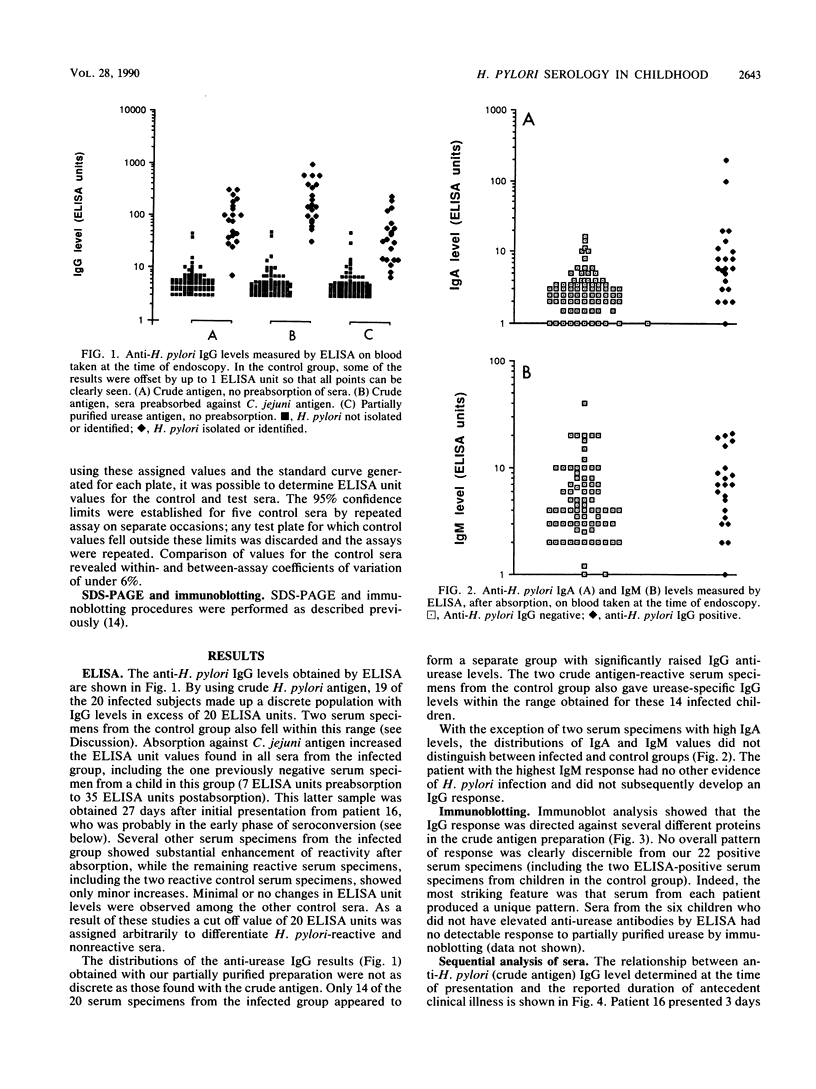
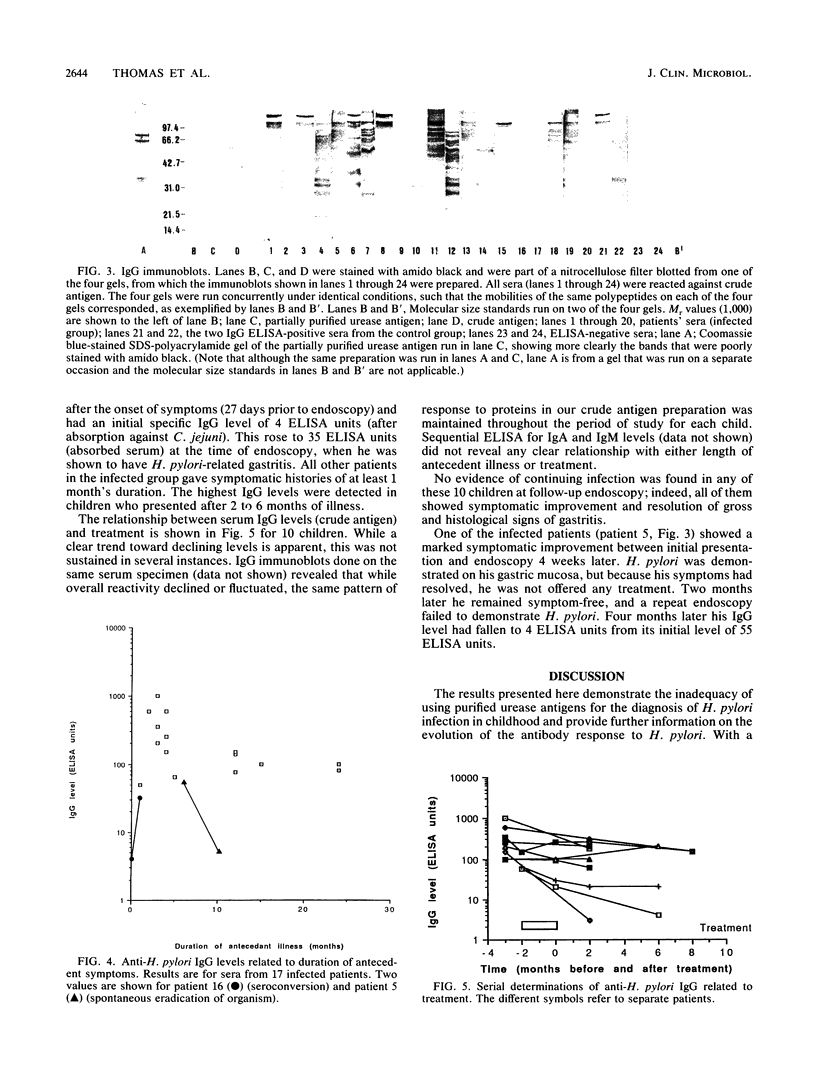
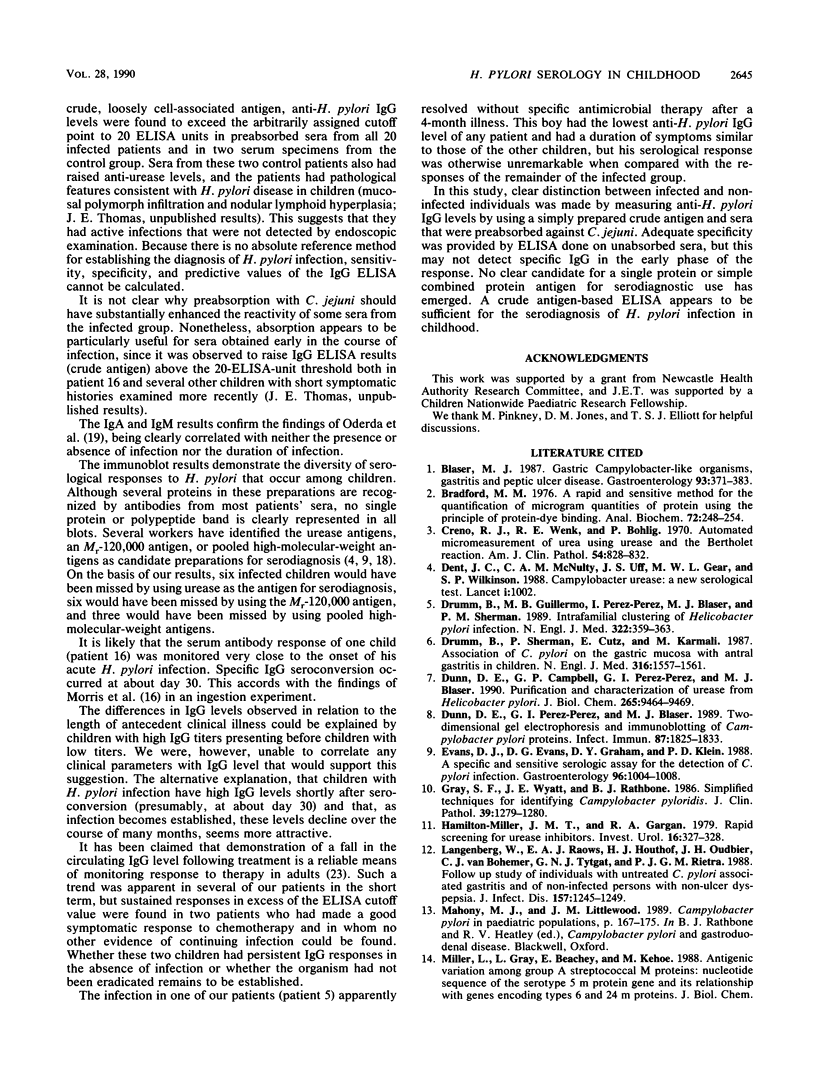
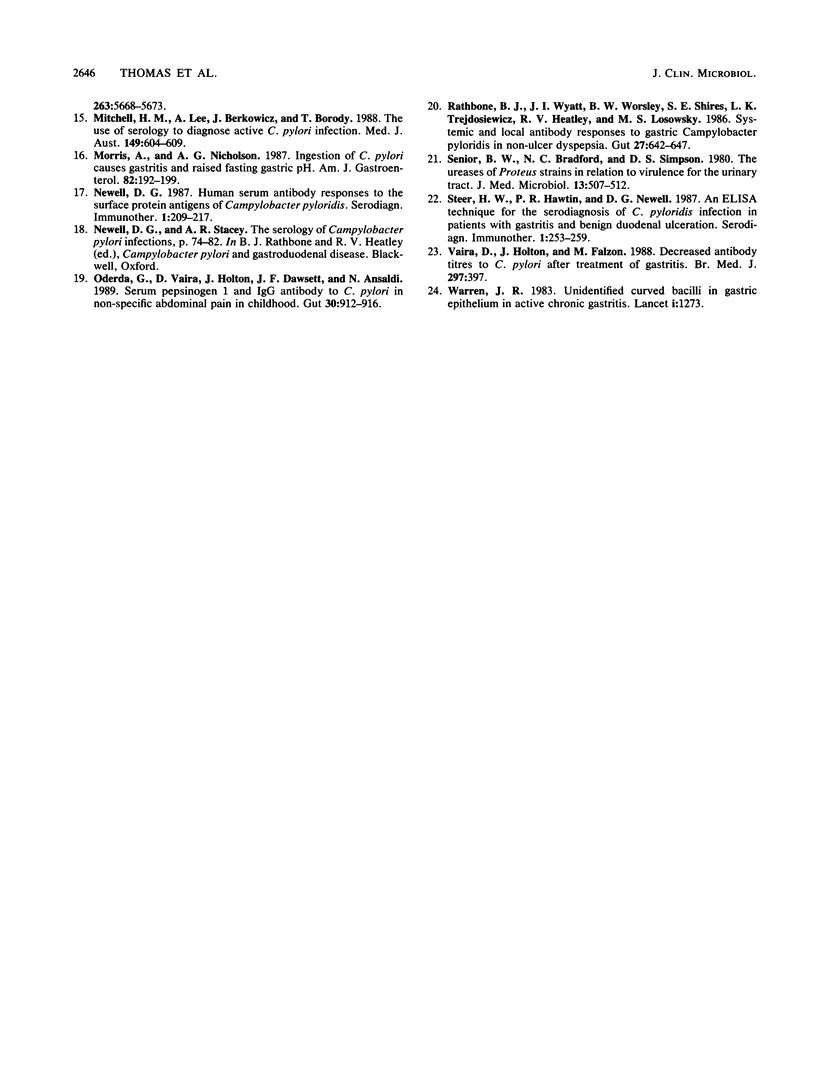
Images in this article
Selected References
These references are in PubMed. This may not be the complete list of references from this article.
- Blaser M. J. Gastric Campylobacter-like organisms, gastritis, and peptic ulcer disease. Gastroenterology. 1987 Aug;93(2):371–383. doi: 10.1016/0016-5085(87)91028-6. [DOI] [PubMed] [Google Scholar]
- Bradford M. M. A rapid and sensitive method for the quantitation of microgram quantities of protein utilizing the principle of protein-dye binding. Anal Biochem. 1976 May 7;72:248–254. doi: 10.1016/0003-2697(76)90527-3. [DOI] [PubMed] [Google Scholar]
- Creno R. J., Wenk R. E., Bohlig P. Automated micromeasurement of urea using urease and the Berthelot reaction. Am J Clin Pathol. 1970 Dec;54(6):828–832. doi: 10.1093/ajcp/54.6.828. [DOI] [PubMed] [Google Scholar]
- Dent J. C., McNulty C. A., Uff J. S., Gear M. W., Wilkinson S. P. Campylobacter pylori urease: a new serological test. Lancet. 1988 Apr 30;1(8592):1002–1002. doi: 10.1016/s0140-6736(88)91827-2. [DOI] [PubMed] [Google Scholar]
- Drumm B., Perez-Perez G. I., Blaser M. J., Sherman P. M. Intrafamilial clustering of Helicobacter pylori infection. N Engl J Med. 1990 Feb 8;322(6):359–363. doi: 10.1056/NEJM199002083220603. [DOI] [PubMed] [Google Scholar]
- Drumm B., Sherman P., Cutz E., Karmali M. Association of Campylobacter pylori on the gastric mucosa with antral gastritis in children. N Engl J Med. 1987 Jun 18;316(25):1557–1561. doi: 10.1056/NEJM198706183162501. [DOI] [PubMed] [Google Scholar]
- Dunn B. E., Campbell G. P., Perez-Perez G. I., Blaser M. J. Purification and characterization of urease from Helicobacter pylori. J Biol Chem. 1990 Jun 5;265(16):9464–9469. [PubMed] [Google Scholar]
- Dunn B. E., Perez-Perez G. I., Blaser M. J. Two-dimensional gel electrophoresis and immunoblotting of Campylobacter pylori proteins. Infect Immun. 1989 Jun;57(6):1825–1833. doi: 10.1128/iai.57.6.1825-1833.1989. [DOI] [PMC free article] [PubMed] [Google Scholar]
- Evans D. J., Jr, Evans D. G., Graham D. Y., Klein P. D. A sensitive and specific serologic test for detection of Campylobacter pylori infection. Gastroenterology. 1989 Apr;96(4):1004–1008. doi: 10.1016/0016-5085(89)91616-8. [DOI] [PubMed] [Google Scholar]
- Gray S. F., Wyatt J. I., Rathbone B. J. Simplified techniques for identifying Campylobacter pyloridis. J Clin Pathol. 1986 Nov;39(11):1279–1279. doi: 10.1136/jcp.39.11.1279-a. [DOI] [PMC free article] [PubMed] [Google Scholar]
- Hamilton-Miller J. M., Gargan R. A. Rapid screening for urease inhibitors. Invest Urol. 1979 Mar;16(5):327–328. [PubMed] [Google Scholar]
- Langenberg W., Rauws E. A., Houthoff H. J., Oudbier J. H., van Bohemen C. G., Tytgat G. N., Rietra P. J. Follow-up study of individuals with untreated Campylobacter pylori-associated gastritis and of noninfected persons with non-ulcer dyspepsia. J Infect Dis. 1988 Jun;157(6):1245–1249. doi: 10.1093/infdis/157.6.1245. [DOI] [PubMed] [Google Scholar]
- Mitchell H. M., Lee A., Berkowicz J., Borody T. The use of serology to diagnose active Campylobacter pylori infection. Med J Aust. 1988 Dec 5;149(11-12):604–609. doi: 10.5694/j.1326-5377.1988.tb120800.x. [DOI] [PubMed] [Google Scholar]
- Morris A., Nicholson G. Ingestion of Campylobacter pyloridis causes gastritis and raised fasting gastric pH. Am J Gastroenterol. 1987 Mar;82(3):192–199. [PubMed] [Google Scholar]
- Oderda G., Vaira D., Holton J., Dowsett J. F., Ansaldi N. Serum pepsinogen I and IgG antibody to Campylobacter pylori in non-specific abdominal pain in childhood. Gut. 1989 Jul;30(7):912–916. doi: 10.1136/gut.30.7.912. [DOI] [PMC free article] [PubMed] [Google Scholar]
- Rathbone B. J., Wyatt J. I., Worsley B. W., Shires S. E., Trejdosiewicz L. K., Heatley R. V., Losowsky M. S. Systemic and local antibody responses to gastric Campylobacter pyloridis in non-ulcer dyspepsia. Gut. 1986 Jun;27(6):642–647. doi: 10.1136/gut.27.6.642. [DOI] [PMC free article] [PubMed] [Google Scholar]
- Senior B. W., Bradford N. C., Simpson D. S. The ureases of Proteus strains in relation to virulence for the urinary tract. J Med Microbiol. 1980 Nov;13(4):507–512. doi: 10.1099/00222615-13-4-507. [DOI] [PubMed] [Google Scholar]
- Unidentified curved bacilli on gastric epithelium in active chronic gastritis. Lancet. 1983 Jun 4;1(8336):1273–1275. [PubMed] [Google Scholar]
- Vaira D., Holton J., Cairns S. R., Falzon M., Polydorou A., Dowsett J. F., Salmon P. R. Antibody titres to Campylobacter pylori after treatment for gastritis. BMJ. 1988 Aug 6;297(6645):397–397. doi: 10.1136/bmj.297.6645.397. [DOI] [PMC free article] [PubMed] [Google Scholar]



